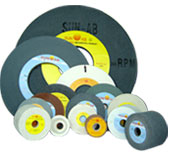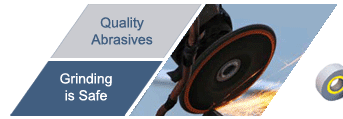| |
|
|
| |

|
Technology |
|
ABRASIVES
are natural minerals or of artificial origin crushed to
grains and sorted to sizes, bonded to hardness or
grades, structured to porous and shaved to sizes.
BONDED abrasives
are made by incorporating abrasives grains - Corundum (
Al2 O3 ), CBN ( Cubic Boron
Nitride ), Carborundum ( Black/Green Silicon Carbide ).
. . . into a matrix,
which can be
inorganic-
vitrified, magnesite,..... bonds and
organic
- resinoid, rubber,......
Inorganic:
-
vitrified bonds are multi-component mixtures of finely
crushed materials including refractory clay, boron
glass, talc, quartz, feldspar, etc. The soluble glass,
dextrine and the likes are added for increasing the
plasticity. Vitrified bonds are porous inbuilt with high
refractory properties, water resistance, chemical
resistance & comparatively high strength. Thus,
vitrified bonded wheels are less prone to loading, are
free-cutting and suitable for wet grinding. The
vitrified bonds are brittle and thus sensitive to
impacts. The vitrified bonds are divided into fusing (
vitreous - glass ) & sintering ( porcelain - type ).
Synthetic corundum tools are made with fusing bonds,
while silicon carbide tools are made with sintered
bonds.
- magnesite bond is formed by a mixture of caustic
magnesite and magnesium chloride forming an
air-hardening paste. The feature of this bond is low
heat generation & wear out fast & have a weak profile
thus have a limited use in dry grindings.
Organic:
-
resinoid
bond is the most popular among organic bonds. It is made
of artificial resin in liquid or powder form ( bakelite
). This bond not only provides higher grinding and
cutting speeds but also offers high strength. Under
harsh condition the cutting temperatures of 300 degree C
and higher, the bond burns out and releases the grains.
The feature of the resinoid bond is low heat resistance
and are sensitive to alkali solutions thus generally
used without coolants.
-rubber bonds are elastic bonds thus used both for
preliminarily grinding and for polishing. With the
increase in pressure during application the grains
penetrate deep into the bond thus decreasing the cutting
depth and giving a better surface finish. Rubber bonded
abrasive tools are less porous generate more heat on the
work piece. The rubber bond softens and burns out at a
temperature of 150 degree C. The feature of rubber
bonded
wheels is that it can be manufactured in low thickness
as tenths of a millimeter which other bonds cannot
achieve.
The hardness,
or grade, of abrasive tools is the resistance of the
bond to part away abrasive grains from the surface of
the tools under the action of external forces. The
concept of hardness ( grade ) is totally different from
the abrasive material, which characterizes the ability
of the material to penetrate the bodies. The soft acting
abrasive tools can be made with hard abrasive and vice
versa hard abrasive can be made with soft abrasive
materials.
COATED abrasives
are made of abrasive grains adhered to the surface of
the flexible or semi-flexible backings like paper,
cloth, vulcanized fiber, plastic films and have
industrial and domestic applications. The coated
abrasive products have both hand and machine use to
achieve fine finishes.
|
|
|
|
|
|
 |





